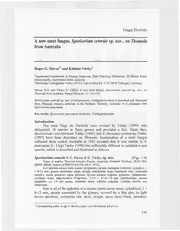
A new smut fungus, Sporisorium centrale sp. nov., on Themeda from Australia PDF
Preview A new smut fungus, Sporisorium centrale sp. nov., on Themeda from Australia
Fungal Diversity A new smut fungus, Sporisorium centrale sp. nov., on Themeda from Australia Roger G. Shivas1* and Kalman Vanky2 lQueensland Department of Primary Industries, Plant Pathology Herbarium, 80 Meiers Road, Indooroopilly, Queensland 4068, Australia 2Herbarium Ustilaginales Vanky (HUV), Gabriel-Biel-Str. 5,0-72076 Tiibingen, Germany Shivas, R.G. and Vanky, K. (2002). A new smut fungus, Sporisorium centrale sp. nov., on Themeda from Australia. Fungal Diversity 11: 141-144. Sporisorium centrale sp. novo(Ustilaginaceae, Ustilaginomycetes) is described and illustrated from Themeda triandra collected in the Northern Territory, Australia. It is compared with Sporisorium punctatum. Key words: Sporisorium punctatum, taxonomy, Ustilaginomycetes. Introduction The smut fungi on Themeda were revised by Vanky (1994) who recognised 18 species in three genera and provided a key. Since then, Sporisorium exsertiformum Vanky (1995) and S. themedae-cymbariae Vanky (1997) have been described on Themeda. Examination of a smut fungus collected from central Australia in 1933 revealed that it was similar to S. punctatum (L. Ling) Vanky (1994) but sufficiently different to establish a new species, which is described and illustrated as follows. Sporisorium centrale R.G. Shivas & K. Vanky, sp. novo (Figs. 1-4) Typus in matrice Themeda triandra Forssk., Australia, Northern Territory, 29.IV.1933 (BRlP 26820). Isotypi in PERTH 831034, HUV 19722. Sori spiculas omnes unius racemi occupantes, (aristae numquam visibiles), cylindrici, 1 x 8-12 mm, glumis plerumque celati, peridio cinerascenti usque brunneolo tecti, columella simplex, massa sporarum nigra, pulverea. Sporae maturae singulae, globosae, subglobosae, ovoideae usque subpolyedrice irregulares, 7.5-9 x 8-11(-15) /-Im, rufobrunneae; pariete aequaliter, ca. 1.0 /-Im crasso, moderate dense, subtliter punctato. Cellulae steriles non observatae. Sori in all of the spikelets of a raceme (awns never seen), cylindrical, 1 x 8-12 mm, mostly concealed by the glumes, covered by a thin grey to light brown peridium, columella one, stout, simple, spore mass black, powdery . •Corresponding author: Roger G. Shivas; e-mail: [email protected] 141 Figs. 1-4. Sporisorium centrale (from holotype) 1. Sori in an infected raceme. 2. Spores in LM. 3. Spores in SEM. 4. Surface ornamentation of spores in SEM. Bars: 1 =5 mm; 2 = 10 ~m; 3, 4 = 1~m. Spores when mature single, globose, subglobose, ovoid to subpolyhedrally irregular, 7.5-9 x 8-11(-15) ~m, reddish-brown; wall even, ca. 1.0 ~m thick, moderately densely, finely punctate. Sterile cells not seen. Known only from the type collection in Australia. Notes: Sporisorium centrale closely resembles S. punctatum in sorus and spore morphology. One difference between these two species is that under Nomarski interference light microscopy (LM) the spore wall of S. centrale is finely punctate (Fig. 2), whereas that of S. punctatum (BPI 177245!) is finely punctate-verruculose (Fig. 6). Scanning electron microscopy (SEM) showed that the spore wall of S. centrale was covered only in coarse verrucae (Fig. 3). 142 Fungal Diversity Figs. 5-9. Sporisorium punctatum (from BPI 177245, holotype) 5. Sori in an infected raceme (arrow indicates awn of healthy spikelet). 6. Spores in LM. 7. Sterile cells and spores in LM. 8. Spores in SEM. 9. Surface ornamentation of spores in SEM. Bars: 5= 5 mm; 6, 8= 10/lm; 7= 20 /lm; 9 = 1/lm. The spore wall ofS.punctatum comprised two types of ornamentation, namely moderate densely, coarse verrucae interspersed with densely, minute verrucae (Figs. 8, 9). Sporisorium centrale appears to infect all spikelets in a raceme (Fig. 1), unlike racemes infected with S. punctatum that occasionally have awns, indicating uninfected spikelets (Fig. 5). The spores of S. centrale are reddish brown, whereas those of S. punctatum are light brown. The peridium of S. centrale is much thinner than theperidium ofS.punctatum. 143 Acknowledgements We are grateful to Desley Tree (Herbarium BRIP) who prepared the SEM photographs and to Don Barrett (University of Queensland) for assistance with the botanical Latin. We thank the Director and Curator of Herbarium BPI (Beltsville, USA) for lending specimens. References Vanky, K. (1994). Taxonomical studies on Ustilaginales. XI. Mycotaxon 51: 153-174. Vanky, K. (1995). Taxonomical studies on Ustilaginales. XIII. Mycotaxon 56: 197-216. xv. Vanky, K. (1997). Taxonomical studies on Ustilaginales. Mycotaxon 62: 127-150. (Received 26 March 2002; accepted 20 May 2002) 144
